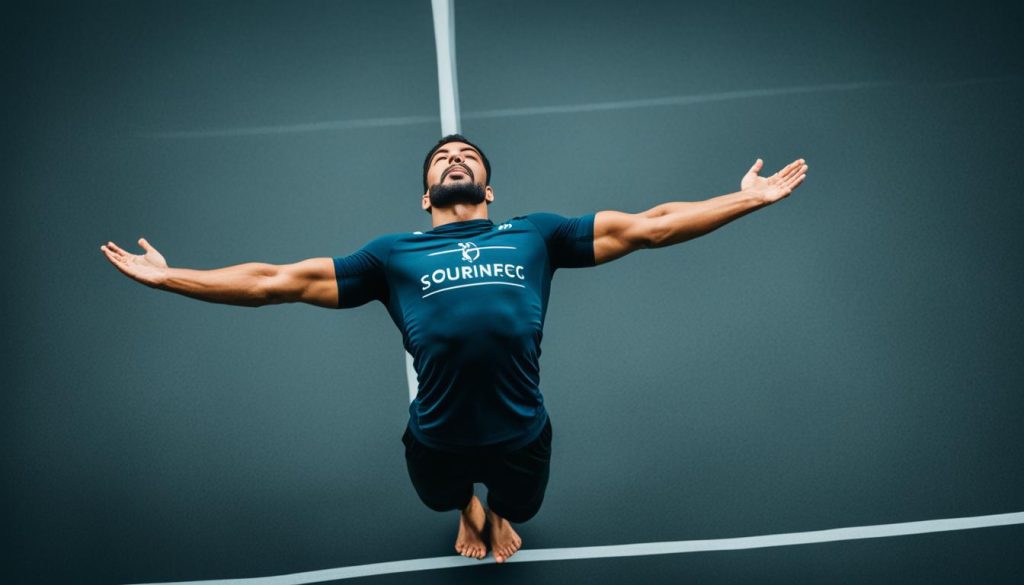When it comes to projecting confidence, it’s not just about what you say but also how you say it. Your body language can speak volumes, sending powerful signals to those around you. By mastering the art of confident body language, you can enhance your self-esteem and make a lasting impression in any social or professional setting.
Key Takeaways:
- Practicing confident body language can increase self-esteem and enhance non-verbal communication skills.
- Maintaining eye contact demonstrates interest and confidence in social interactions.
- Posture plays a significant role in projecting self-assuredness and openness.
- Deliberate hand gestures and movements can emphasize points and convey confidence.
- A firm handshake conveys professionalism and assertiveness.
The Power of Maintaining Eye Contact
Maintaining eye contact is a crucial element of projecting confidence through body language. When you engage in good eye contact, it sends a powerful message to others that you are interested and comfortable in the conversation. This simple yet impactful gesture can significantly enhance your ability to project confidence and make a positive impression on those around you.
Start by looking the other person in the eye about 60% of the time during a conversation. As you become more comfortable, gradually increase the duration of eye contact. This gradual progression allows you to maintain a natural flow while building a connection through attentive and engaged eye contact.
Avoid the temptation to look at the ground or around the room, as it can convey disinterest or lack of confidence. Instead, focus on maintaining consistent eye contact with the person you are conversing with. This intentional attention demonstrates your confidence and genuine interest in the conversation.
Consistent eye contact not only projects confidence but also helps establish trust and rapport. It shows that you are fully present and actively listening to the other person, making them feel valued and respected. This can lead to more meaningful and productive social interactions.
“Maintaining eye contact is like a window into the soul. It allows you to connect with others on a deeper level and establish a powerful presence.”
– Jane Smith, Body Language Expert
Benefits of Maintaining Eye Contact
- Builds trust and rapport
- Enhances active listening skills
- Demonstrates interest and engagement
- Projects confidence and assertiveness
- Makes a memorable impression
It is important to note that maintaining eye contact should feel natural and comfortable. Avoid staring intensely or holding eye contact for an extended period, as this can come across as intimidating or aggressive. Strike a balance by being present and attentive while respecting personal boundaries.
By mastering the art of maintaining eye contact, you can unlock the power of confident body language and project an air of self-assuredness in your social interactions. Remember, eye contact is a powerful tool that reflects your confidence and makes a lasting impression. Practice and embrace eye contact as a valuable skill in projecting confidence and enhancing your non-verbal communication.
The Impact of Posture on Confidence

When it comes to projecting confidence through body language, your posture plays a crucial role. The way you stand or sit can speak volumes about your self-assurance and level of confidence. By adopting a confident posture, you can instantly improve your overall body language and project a sense of confidence to those around you.
Confident posture is characterized by standing or sitting with a straight back, shoulders pulled back, and uncrossed arms and legs. This open and expansive posture conveys a sense of self-assuredness and assertiveness. It shows that you are comfortable in your own skin and ready to take on any challenge.
On the other hand, slouching or taking up as little space as possible can make you appear anxious or lacking in confidence. It sends a message that you are uncomfortable or unsure of yourself. By avoiding these posture habits and consciously adopting confident body language, you can greatly enhance your presence and the way others perceive you.
“Confidence is not only reflected in what you say; it is also communicated through your posture. By standing tall and maintaining an open and assertive stance, you not only feel more confident, but you also project that confidence to the world.”
It’s important to note that confident posture extends beyond physical appearance – it also affects your mental state. Studies have shown that assuming a powerful body posture, such as standing with your hands on your hips and feet apart (also known as a power pose), can lead to increased confidence and assertiveness levels. This demonstrates the strong connection between our physical posture and our psychological state.
Overall, confident posture is a key component of assertive body language and projecting confidence. By paying attention to your posture and making the necessary adjustments, you can effectively communicate your self-assurance to others and improve your overall non-verbal communication skills.
Key Takeaways:
- Confident posture involves standing or sitting with a straight back, shoulders pulled back, and uncrossed arms and legs.
- Avoid slouching or taking up as little space as possible, as this can make you appear anxious or lacking in confidence.
- Confident posture not only enhances your physical appearance but also affects your mental state.
- By consciously adopting confident body language, you can project an air of confidence and improve your overall non-verbal communication skills.
The Role of Hand Gestures and Movements

Hand gestures and movements play a crucial role in conveying confidence through body language. When used appropriately, they can enhance your overall non-verbal communication and make a powerful impression. Here are some key tactics to keep in mind:
- Avoid fidgeting or keeping your hands in your pockets, as these actions can send signals of nervousness or anxiety.
- Instead, use deliberate and purposeful hand gestures to emphasize your points and convey confidence. Remember to keep your gestures controlled and meaningful, avoiding excessive movements that may appear distracting.
- Taking up space with your gestures and movements can send a message that you are not afraid to be seen and heard. This sends a powerful signal of confidence and assertiveness.
By incorporating confident body movements into your non-verbal communication, you can project self-assurance and establish a stronger presence. Remember to practice and refine your gestures to ensure they align with your intended message and reinforce your overall confident image.
The Power of Power Poses
In addition to hand gestures and movements, power poses are another technique that can help you project confidence. Power poses involve adopting expansive and open body positions that signal dominance and assertiveness. These poses can have a direct impact on your internal state, boosting your confidence and reducing stress levels.
Research conducted by social psychologist Amy Cuddy has shown that holding a power pose for just a few minutes before a high-stakes situation can significantly increase feelings of confidence and improve performance. Some examples of power poses include:
| Power Pose | Description |
|---|---|
| The Wonder Woman pose: Stand tall with your feet shoulder-width apart, place your hands on your hips, and lift your chin. | |
| The CEO pose: Sit or stand with your legs slightly apart, lean back and rest your hands behind your head. |
Adopting these power poses before important meetings, presentations, or interviews can help you exude confidence and perform at your best. Remember to hold the pose for at least two minutes to experience the desired effects.
“Confident hand gestures and purposeful movements can enhance your non-verbal communication, instantly projecting self-assurance and charisma to those around you.”
By becoming mindful of your hand gestures, movements, and overall body language, you can harness their power to convey confidence and make a lasting impression. Practice incorporating confident body movements and power poses into your daily interactions, and observe the positive impact they have on your personal and professional relationships.
The Importance of a Firm Handshake
In effective non-verbal communication, a firm handshake holds significant power. It conveys confidence and professionalism, making it an essential aspect of projecting confident body language. A weak or limp handshake can send a message of doubt and uncertainty, undermining your credibility. Instead, aim for an assertive handshake that showcases your self-assurance.
When engaging in a handshake, be sure to grip the other person’s hand firmly, using enough pressure to demonstrate strength but not too much to avoid discomfort. The duration of the handshake should be around three seconds or less, as prolonged handshakes can create a sense of awkwardness. Remember, a confident handshake is a balance between strength, warmth, and brevity.
By mastering the art of a firm handshake, you can make a strong first impression and project confidence in various social and professional settings. In job interviews, meetings, or networking events, a well-executed handshake can leave a lasting positive impression, signaling your self-assurance and ability to command attention.
“A firm handshake is the key to building trust and creating a positive connection. It sets the tone for any interaction and instantly communicates your level of confidence.”
The Elements of a Confident Handshake
When delivering a firm handshake, consider the following elements:
- Grip: Grip the other person’s hand firmly, ensuring a balanced amount of pressure.
- Eye Contact: Maintain eye contact during the handshake to establish a sense of connection and confidence.
- Body Language: Maintain an upright posture and avoid any signs of nervousness or anxiety.
| Do | Don’t |
|---|---|
| SMILE | LOOK AWAY |
| MAINTAIN EYE CONTACT | OFFER A LIMP HAND |
| STAND UPRIGHT | DISPLAY NERVOUS TICS |
Remember, a firm handshake is just one element of confident body language. Combined with other non-verbal cues such as eye contact, posture, and assertive gestures, it can significantly enhance your overall presence and communication skills.
Mirroring and Non-Verbal Synchronization
When it comes to non-verbal communication, there is a powerful technique called mirroring that can greatly enhance your interactions. Mirroring, also known as the chameleon effect, involves mimicking someone’s body language and movements. By doing so, you send a signal that you are paying attention and create a sense of rapport and connection with the other person. Mirroring can be a game-changer in strengthening relationships and making you feel more comfortable and confident in social interactions.
Practicing mirroring entails observing and subtly imitating the body language cues of the person you are interacting with. For example, if they cross their legs or put their hands on their hips, you can mirror this behavior by doing the same. The key is to do it in a subtle and natural way, without making it obvious or exaggerated. This technique creates a subconscious connection between you and the other person, building trust and making the conversation flow more smoothly.
While mirroring is effective in most situations, it’s essential to be mindful of cultural differences and individual preferences. Some individuals may find mirroring uncomfortable or manipulative if done excessively or without awareness. Always pay attention to the other person’s reactions and adjust your mirroring accordingly.
Benefits of Mirroring:
- Builds rapport and connection
- Enhances communication and understanding
- Creates a sense of trust and empathy
- Makes the other person feel validated and heard
- Improves overall non-verbal communication skills
By incorporating mirroring into your non-verbal communication repertoire, you can establish a deeper connection with others and foster positive relationships. Remember to practice mirroring in a respectful and subtle manner, using it as a tool to build rapport and create a comfortable environment for effective communication.
Conclusion
Mastering confident body language is a powerful skill that can transform your personal and professional interactions. By incorporating simple yet effective techniques into your daily routine, you can project an air of confidence and effectively communicate your self-assurance to others.
One of the key elements of projecting confidence is maintaining eye contact. By looking others in the eye, you convey interest, attentiveness, and a sense of presence. Additionally, adopting a confident posture – standing tall with shoulders back and uncrossed arms and legs – helps create an aura of self-assuredness.
Hand gestures and movements also play a crucial role in body language. Avoid fidgeting or keeping your hands hidden, and instead use purposeful gestures to emphasize your words and convey confidence. Additionally, a firm handshake can make a strong first impression and demonstrate your assertiveness.
Furthermore, mirroring others’ body language can help establish rapport and create a sense of connection. By subtly imitating their gestures and movements, you convey that you are listening and engaged in the interaction.
Remember, projecting confidence through body language is a skill that can be learned and practiced. By implementing these confident body language tips into your daily life, you can enhance your self-esteem, build stronger relationships, and make a positive impact on those around you.
FAQ
How can I project confidence through body language?
There are several ways to project confidence through body language. Some tips include maintaining eye contact, standing up straight with uncrossed arms and legs, using deliberate hand gestures, and adopting a firm handshake. By practicing these techniques, you can project an air of confidence and improve your overall non-verbal communication skills.
Why is maintaining eye contact important for projecting confidence?
Maintaining eye contact is important because it shows others that you are interested and comfortable in the conversation. By looking the other person in the eye and avoiding distractions, you can make a strong impression and convey confidence in social interactions.
How does posture impact confidence?
Posture plays a significant role in projecting confidence. Standing or sitting with a straight back, shoulders pulled back, and uncrossed arms and legs conveys a sense of self-assuredness and openness. By adopting a confident posture, you can instantly improve your body language and project confidence to those around you.
What is the role of hand gestures and movements in projecting confidence?
Hand gestures and movements are important aspects of projecting confidence. Avoid fidgeting or keeping your hands in your pockets, as this can convey nervousness or anxiety. Instead, use deliberate and purposeful hand gestures to emphasize your points and convey confidence. By using confident body movements, you can enhance your overall non-verbal communication and appear more self-assured.
Why is a firm handshake important for projecting confidence?
A firm handshake is a powerful non-verbal cue that conveys confidence and professionalism. Offering a limp or weak handshake can signal a lack of confidence. By aiming for a firm and assertive handshake, you can make a strong first impression and project confidence in social and professional settings.
What is mirroring and how does it impact non-verbal communication?
Mirroring, also known as the chameleon effect, is a powerful non-verbal communication technique. When you mirror someone’s body language and movements, it shows that you are paying attention and builds a sense of rapport and connection. Mirroring can help strengthen relationships and make you feel more comfortable and confident in social interactions.
How can practicing confident body language improve overall self-esteem?
Practicing confident body language can increase your self-esteem and help you feel more confident in social situations. By incorporating confident body gestures, maintaining eye contact, adopting a confident posture, using assertive handshakes, and mirroring others, you can project an air of confidence and improve your overall non-verbal communication skills. Confidence can be learned and cultivated, and mastering these techniques can enhance your self-esteem and make a positive impression on those around you.

